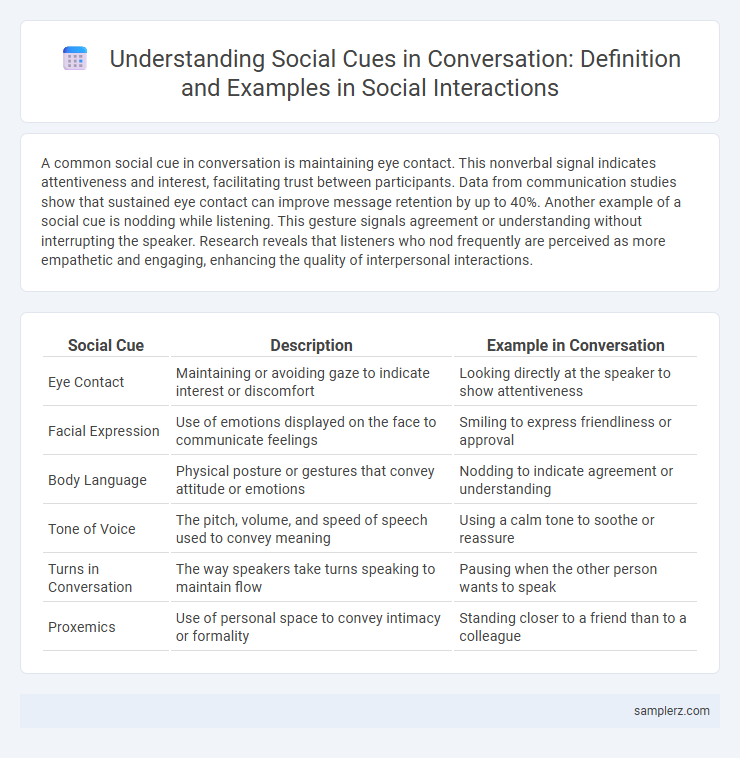A common social cue in conversation is maintaining eye contact. This nonverbal signal indicates attentiveness and interest, facilitating trust between participants. Data from communication studies show that sustained eye contact can improve message retention by up to 40%. Another example of a social cue is nodding while listening. This gesture signals agreement or understanding without interrupting the speaker. Research reveals that listeners who nod frequently are perceived as more empathetic and engaging, enhancing the quality of interpersonal interactions.
Table of Comparison
| Social Cue | Description | Example in Conversation |
|---|---|---|
| Eye Contact | Maintaining or avoiding gaze to indicate interest or discomfort | Looking directly at the speaker to show attentiveness |
| Facial Expression | Use of emotions displayed on the face to communicate feelings | Smiling to express friendliness or approval |
| Body Language | Physical posture or gestures that convey attitude or emotions | Nodding to indicate agreement or understanding |
| Tone of Voice | The pitch, volume, and speed of speech used to convey meaning | Using a calm tone to soothe or reassure |
| Turns in Conversation | The way speakers take turns speaking to maintain flow | Pausing when the other person wants to speak |
| Proxemics | Use of personal space to convey intimacy or formality | Standing closer to a friend than to a colleague |
Understanding Social Cues in Everyday Conversations
Understanding social cues in everyday conversations helps individuals recognize nonverbal signals such as eye contact, facial expressions, and body language that indicate emotions or intentions. For example, a smile often signals friendliness and openness, while crossed arms might suggest discomfort or defensiveness. Accurately interpreting these subtle clues enhances communication effectiveness and fosters stronger social connections.
Nonverbal Gestures That Signal Interest
Leaning forward and maintaining eye contact are key nonverbal gestures that signal interest during social conversations. Nodding in response to statements conveys active listening and engagement. Subtle facial expressions, such as smiling or raised eyebrows, further indicate attentiveness and positive reception.
The Impact of Eye Contact as a Social Cue
Eye contact serves as a powerful social cue in conversation, signaling attention, interest, and emotional connection between individuals. Maintaining appropriate eye contact can enhance trust and understanding, while avoiding gaze may indicate discomfort, disinterest, or deception. Research shows that 60-70% eye contact in a face-to-face interaction optimizes communication effectiveness and strengthens social bonds.
Tone of Voice and Its Social Significance
Tone of voice in conversation, such as a warm, friendly pitch, signals openness and fosters trust between participants. A sharp or raised tone can indicate frustration or urgency, prompting listeners to adjust their responses accordingly. Recognizing these vocal cues enhances social understanding and effective communication in various interpersonal interactions.
Interpreting Personal Space in Dialogue
Interpreting personal space in dialogue involves recognizing the physical distance someone maintains during a conversation, which signals their comfort level and social boundaries. For instance, stepping back when a person leans in closer indicates a need for more space, reflecting respect for their personal bubble. Understanding these spatial cues helps navigate social interactions effectively, preventing discomfort and fostering positive communication.
The Role of Facial Expressions in Communication
Facial expressions serve as powerful social cues that convey emotions such as happiness, anger, or confusion during conversations, enhancing interpersonal understanding without words. Microexpressions, brief involuntary facial movements, reveal genuine feelings and can influence trust and empathy between individuals. Recognizing these nonverbal signals improves communication effectiveness by providing insight into unspoken thoughts and emotional states.
Timing and Turn-Taking: Key Social Signals
Timing and turn-taking in conversation serve as crucial social cues that regulate smooth interpersonal communication. Pausing briefly before responding signals attentiveness and respect for the speaker's input, while timely interruptions may indicate enthusiasm or urgency. Effective management of these cues fosters mutual understanding and prevents conversational overlap or awkward silences.
Mirroring Behavior for Building Rapport
Mirroring behavior, such as subtly copying a conversation partner's body language, tone, or expressions, is a powerful social cue for building rapport. This technique fosters trust and empathy by creating a sense of similarity and understanding between individuals. Studies show that effective mirroring enhances communication outcomes and strengthens interpersonal connections in social and professional settings.
Reading Subtle Body Language in Social Interactions
Subtle body language cues like fleeting eye contact, brief smiles, or slight shifts in posture reveal a person's comfort level and engagement during social interactions. Recognizing these nonverbal signals enhances empathy and conversational flow by indicating when to speak or listen. Understanding microexpressions and subtle gestures aids in decoding unspoken emotions, improving social connection and rapport.
Contextual Cues and Their Effects on Conversation
In conversation, contextual cues such as body language, tone of voice, and facial expressions significantly influence interpretation and response. For example, a raised eyebrow or a slight pause can signal skepticism or hesitation, guiding the listener's understanding and adjusting the flow of dialogue. These non-verbal signals enrich communication by providing deeper insight beyond spoken words, enhancing the effectiveness of social interactions.

example of social cue in conversation Infographic
 samplerz.com
samplerz.com